What do you think of when you imagine a hyena? A cackling, meat-eating character, right? Turns out, they’re not all like that. Like any family, there’s one member of the hyena clan that’s something of an oddball – the aardwolf (Proteles cristatus).
The name might conjure up images of the cursed result of an experiment between a wolf and a very brave aardvark, but aardwolf actually means “earth wolf” in Afrikaans, dubbed so after the way these animals make their dens out of holes in the ground.

It’s a hard life eating that many termites.
Image credit: Madelein Wolfaardt/Shutterstock.com
Plus, if you take a look at an aardwolf, you’ll soon get a much more sensible idea of where it lies on the tree of life. It might be the smallest of its relatives, but the aardwolf heavily resembles the bigger striped hyena (Hyaena hyaena), with the characteristic bristled-up mane running down its back, dark stripes on yellow-brown fur, and forelegs longer than their hind legs.
That is, until you take a closer look inside its mouth. At first, it’s familiar hyena territory – sharp canine teeth that you’d do well to stay away from outside of this imaginary dental scenario. But go further back to where the molars are, and instead of the usual pronounced shape evolved for meat-grinding, you’ll find a much flatter, reduced set of pegs
Why? Because these hyenas aren’t out here grinding up gazelle meat – their meal of choice is termites. They really are a bit aardvark-like after all.
Aardwolves can eat up to 300,000 termites per night, using a long, sticky tongue to lick them up from the surface, rather than destroying termite mounds. For some animals, there’s no way you’d catch them near so many termites – the soldiers of the group give off a noxious chemical deterrent. Aardwolves, however, remain unaffected.

Aardwolf tongues are excellent for both blepping and termite-eating.
Their insect-foraging behavior hasn’t just affected their teeth either. Unlike other hyenas, which are social, clan-living animals, aardwolves tend to be solitary. Termites aren’t exactly the type of food that can be easily shared or dragged back to a den.
The result is that the mating season is the only time aardwolves come together (stop it). After a successful encounter, a mother aardwolf will be pregnant for about 90 days before popping out a litter of between two to five cubs.
Aardwolf cubs begin weaning at about three to four months of age, during which time their parents feed them regurgitated termites (yummy) until the cubs are capable of foraging their own dinner. Then, once they hit around a year old, they’ll go off and form their own territory.
The good news is that those adorably fluffy cubs will become fully-fledged members of a species that appears to be thriving. They might not be seen much – mainly because of their typically shy, nocturnal behavior – but aardwolves are considered a species of “least concern” by the IUCN, and are widely distributed in two main populations across southern and eastern Africa.
Maybe less good news if you’re a termite though.
Source Link: Meet The Aardwolf: The Smallest Hyena, With A 300,000-Termite-A-Night Appetite